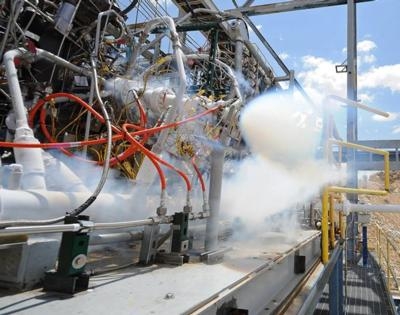Thu, Sep 08, 2016
Final Tests Completed By Aerojet Rocketdyne
The final test series on a sub-scale oxygen rich preburner that is part of U.S. Air Force Research Laboratory (AFRL) Hydrocarbon Boost Technology Demonstrator (HBTD) program has been completed by Aerojet Rocketdyne.

The HBTD program is developing key technologies for rocket engines that employ an oxygen-rich staged combustion (ORSC) engine cycle – the same cycle that is used for the Aerojet Rocketdyne AR1 engine – a potential replacement engine for the Russian RD-180. The reusable HBTD demonstrator engine is a 250,000 lbf thrust class engine that is capable of up to 100 flights, and features high-performance, long-life technologies and modern materials.
“The large quantity of data gathered during this test series is invaluable in anchoring the analytical models that were developed for use with this and future engine programs. We incorporated a novel fuel and oxidizer mixing technology in the preburner design, which yielded an extremely uniform gas temperature throughout the engine,” said Joe Burnett, Aerojet Rocketdyne program manager of the Hydrocarbon Boost Technology Demonstrator program. “Consistent gas temperatures in an engine are critical for turbomachinery performance.”
“At Aerojet Rocketdyne, we evolve rocket science. The Hydrocarbon Boost Technology Demonstrator program is key to a state-of-the-art oxygen-rich staged combustion engine with components that include modern materials using advanced manufacturing techniques,” said Eileen Drake, Aerojet Rocketdyne CEO and president. “What we’ve learned will be instrumental as other engines are developed using this same engine cycle, such as our AR1 engine.”
The series of successful tests also marked the first use of the Mondaloy 200 super alloy, which was developed jointly by Aerojet Rocketdyne and the AFRL Materials Directorate. Mondaloy 200 is an enabling technology for rocket engines that employ the ORSC engine cycle because of its high-strength and burn resistance properties.
(Image provided with Aerojet Rocketdyne news release)
More News
He Attempted To Restart The Engine Three Times. On The Third Restart Attempt, He Noticed That Flames Were Coming Out From The Right Wing Near The Fuel Cap Analysis: The pilot repor>[...]
Make Sure You NEVER Miss A New Story From Aero-News Network Do you ever feel like you never see posts from a certain person or page on Facebook or Instagram? Here’s how you c>[...]
From 2009 (YouTube Edition): Leading Air Show Performers Give Their Best Advice for Newcomers On December 6th through December 9th, the Paris Las Vegas Hotel hosted over 1,500 air >[...]
Aero Linx: NASA ASRS ASRS captures confidential reports, analyzes the resulting aviation safety data, and disseminates vital information to the aviation community. The ASRS is an i>[...]
“For our inaugural Pylon Racing Seminar in Roswell, we were thrilled to certify 60 pilots across our six closed-course pylon race classes. Not only did this year’s PRS >[...]
 NTSB Final Report: Rutan Long-EZ
NTSB Final Report: Rutan Long-EZ ANN FAQ: Turn On Post Notifications
ANN FAQ: Turn On Post Notifications Classic Aero-TV: ICAS Perspectives - Advice for New Air Show Performers
Classic Aero-TV: ICAS Perspectives - Advice for New Air Show Performers ANN's Daily Aero-Linx (06.28.25)
ANN's Daily Aero-Linx (06.28.25) Aero-News: Quote of the Day (06.28.25)
Aero-News: Quote of the Day (06.28.25)



